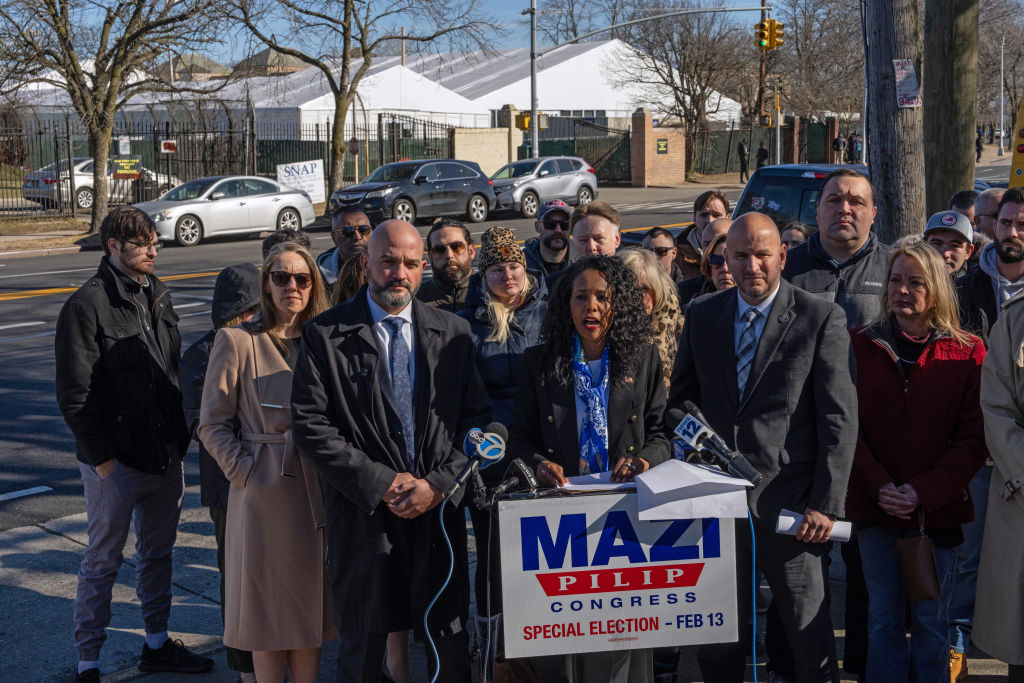George Santos was the ripest harvest yet from America’s post-credential, post-morality Kardsho-Trumpian celebrity era. A politics of influencers, not influence. Our “dirtbag glamor” phase.
But while Santos is gripping at the door to keep from being sucked completely out of the pressurized cabin of fame into the thin atmosphere of ordinary criminal defendants, time—and elections—hurtle onward.
Today, voters in Santos’ old district will choose his replacement for the remainder of the current term. It may seem wasteful that partisans have spent something on the order of $15 million for a nine-month stint in just one of New York’s 26 House districts, but a couple of things to remember: 1) A country that can afford (mostly) to bet a collective $23 billion on the Super Bowl can afford 1/1,500th of that amount for a seat in the House of Representatives and 2) The political world is very anxious right now.
First, some context. Among the many cautionary tales that Santos’ journey can tell us is one about the perils of endless redistricting. Other than as some kind of punishment for our dumb politics, the reason we got Santos in the first place was because the seat he started out running for, New York’s 3rd District, was a sure loser but was redrawn midcampaign into one that would be much easier for a Republican to win.
When Republican Rep. Peter King held the seat for 20 years until 2013, the district was a mix of upper-crust, squishy suburbanites on the North Shore of Long Island and working-class communities like Leavittown on the south side of the Long Island Expressway. DuPonts and Vanderbilts up north, Bill O’Reilly and Billy Joel to the south. It was a tough district for the GOP, but sustainable with a moderate candidate, especially a tireless campaigner like King.
But Democrats in Albany redrew the district ahead of the 2012 election, cutting out the working-class south and spreading along the North Shore, east into Suffolk County, and west into heavily Democratic Queens County, including the home of longtime Democratic Rep. Steve Israel. Israel won the seat, and when he retired in 2016, passed it on to Tom Suozzi, the former county executive for Nassau, who had lost the Democratic primary for governor to Eliot Spitzer in 2006 and then lost his local gig in 2009.
Elected thrice, Suozzi gave up the seat in 2022 to run for governor again, taking on incumbent Kathy Hochul, who had inherited the post a year before by the resignation of Andrew Cuomo. Suozzi again lost the primary. But that may have spared him from a more embarrassing loss at home.
That spring, the New York Court of Appeals threw out the congressional map drawn up by state Democrats for being “drawn with impermissible partisan purpose.” Instead, the midterm elections would use a new map drawn up by a court-appointed special master that was much more favorable to Republicans.
While the GOP struggled nationally, New York Republicans flipped four Democrat-held seats, winning five of six competitive races in the Empire State. One of those was the 3rd District. When Santos started his campaign, he was perfectly positioned for a lucrative outing as a sacrificial lamb. Just as he did in a failed 2020 bid against Suozzi, Santos could raise some cash, get some media attention, and join the ranks of failed New York Republicans plying the television green rooms of Manhattan.
But the new map restored much of the old working-class, Trumpy parts of the district. What began as a novelty race—“the first congressional general election between two openly gay candidates in U.S. history”—with an easily predicted outcome of a Democratic win turned into a dogfight on King’s old stomping ground. It was too late for local Republicans to switch out for a more conservative, better-vetted candidate and Santos obviously has no trouble with reinvention, so away they went.
It was by similar luck that Santos survived the initial revelation of his fabulism and deceit. With only a five-seat majority following their disappointing midterm showing, House Republicans couldn’t afford to give up even one member. With a healthier margin, Hill leaders would have dumped Santos early on to prevent further brand damage. But facing an endless series of nail-biter votes, they were content to look the other way until Santos’ home-state delegation demanded action and made him only the third House member to be expelled since the Civil War.
That brings us to today, when Republicans will get one more crack at the more favorable district lines before another court-ordered redistricting goes into place for the November general election. And they get to do it with a candidate of their choosing, Mazi Pilip. She’s in many ways the authentic version of what Santos held himself out to be. She’s Jewish, not “Jew-ish.” She has an impressive biography and an immigrant success story that was carefully vetted.
On the Democratic side, Suozzi is back. And while he certainly has an advantage in the fact that voters may be keen to punish Republicans for the humiliation of Santos, he doesn’t have the favorable district boundaries within which he won his previous three terms. Neither does he have the issues on his side. This is not a good time to be a Democrat in suburban New York, as locals fume over crime and the migrant crisis and President Joe Biden faces intensifying calls to abandon his reelection bid after a Justice Department report spilled damning details about his age and memory.
On its face, the special election looks like a Republican hold, Santos and all. But what Suozzi and his party are counting on is the continuation of the Trump effect, by which Democrats have continued to turn out in massive numbers for elections since their 2016 presidential defeat.
There are so many asterisks on this race that it would be a mistake to make too many assumptions about November based on today’s results. But, if Democrats manage another win in a hotly contested, high-profile, big-money contest with national implications, not dissimilar to the Virginia midterms in November, it will be another warning sign to Republicans about the state of the suburbs. On the other hand, a Republican win would certainly further shake the confidence of national Democrats who are increasingly despairing about their party’s chances in the fall.







Please note that we at The Dispatch hold ourselves, our work, and our commenters to a higher standard than other places on the internet. We welcome comments that foster genuine debate or discussion—including comments critical of us or our work—but responses that include ad hominem attacks on fellow Dispatch members or are intended to stoke fear and anger may be moderated.
With your membership, you only have the ability to comment on The Morning Dispatch articles. Consider upgrading to join the conversation everywhere.